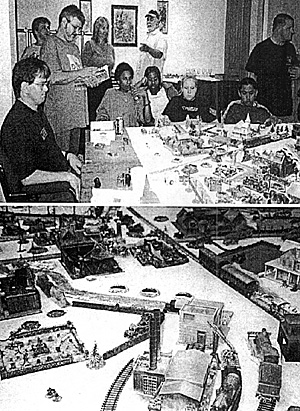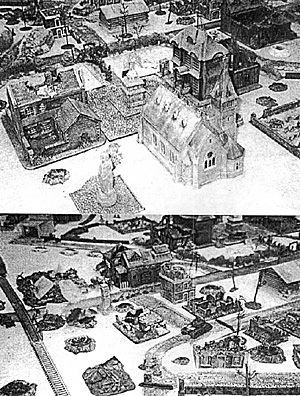 On December 15, 1944 two green American Divisions, the 106th and 28th Infantry Divisions were crushed by an artillery barrage and the attack of several powerful German formations. This was to be Hitler's final offensive in the west. The objective was to divide and roll up the western allied armies, driving to the English Channel through the Ardennes in a repetition of the Blitzkrieg of 1940. Realistically equal success was unlikely. To succeed at all great speed was called for. And only the capture of fuel dumps en route could enable the petroleum starved Wchrmacht to complete the trip.
On December 15, 1944 two green American Divisions, the 106th and 28th Infantry Divisions were crushed by an artillery barrage and the attack of several powerful German formations. This was to be Hitler's final offensive in the west. The objective was to divide and roll up the western allied armies, driving to the English Channel through the Ardennes in a repetition of the Blitzkrieg of 1940. Realistically equal success was unlikely. To succeed at all great speed was called for. And only the capture of fuel dumps en route could enable the petroleum starved Wchrmacht to complete the trip.
On the other hand, winter weather was counted on to offset allied air superiority. The German high command expected to have thirty divisions of their own chewed up in the offensive. But they anticipated that a similar number of British and American divisions would be wrecked, which it was hoped would discourage the western allies into paralysis. Had the thirty divisions been carved out of the Russian forces, as many Germans would have preferred, the impact could not have been decisive.
As a result of the German attack a "Bulge" appeared on the western front, giving the campaign its name "The Battle of the Bulge." It would prove to be the largest land battle in our history. Although it is remembered more for the famous stand of the 101st Airborne Division and fragments of other units the defense of the little Belgian Town of St. Vith from the 17th to the 23rd of December was perhaps of equal or greater importance. This battle began with the commitment of MG Hasbrouk's 7th Armored Division to the St. Vith area to rescue the 106th Infantry and hold up the German advance. It was too late for most of the 106th. But of this battle a knowledgeable critic, Feldmarshal Hasso von Manteuffel stated, at a press conference twenty years later:
"on the evening of 24 December 1944, I recommended to Hitler's Adjutant that the German Army give up the attack and return to the West Wall." He stated that the reason for this recommendation was due to the time lost by his Fifth Panzer Army in the St. Vith area. (Paper: The Battle of St. Vith: A Concept in Defensive Tactics, by General Bruce C. Clarke U.S. Army Ret.)
Naturally, this suggestion did not meet with approval. Hitler had no intention of surviving a lost war. Gotterdamerung, had to be played out. But von Manteuffel's comment makes it clear that the prolonged defense of St. Vith was a decisive factor in the campaign. The defense would be characterized by determined infantry defenses with the direct fire support of tank destroyers and periodic strong local armored counter attacks. (as described by General Clarke, ibid.) This would not have been adequate (due in large part to the tactical inferiority of American armor.) However, a battalion sized remnant of the 106th's Division Artillery (the 275th Field Artillery) and the 7th's own Division Artillery, well sited and responding to skilled forward observers helped blunt the German spearheads and pave the way for local counter attacks.
 This critical WWII engagement has become the basis for an epic wargame. HMGS SOUTH's own Tom Panetta and Richard Huntington have put together an incredibly believable Belgian town in winter, with Churches, parks dwellings, and a complete rail head which, with the road network, made the real St. Vith such a valuable target. The scenery is diorama quality, and seems to improve and expand every time they put on the game. I have seen it run at COLDWARS, RECON, and most recently at BAYOU WARS. In addition to the real estate and railroad rolling stock there are numerous little vignettes. As appropriate there are parties of pitiful refugees, a farmer removing a stump (why bother at that point), prisoners of war being escorted to the rear. And hidden among the dwellings are misbehaving civilians and the odd partisan or forward observer calling down death and destruction on the invaders. If I remember correctly, none other than Uncle Duke Seifried, who was running his Aztec game at BAYOU WARS, served in that capacity and proudly bragged of the destruction he accomplished.
This critical WWII engagement has become the basis for an epic wargame. HMGS SOUTH's own Tom Panetta and Richard Huntington have put together an incredibly believable Belgian town in winter, with Churches, parks dwellings, and a complete rail head which, with the road network, made the real St. Vith such a valuable target. The scenery is diorama quality, and seems to improve and expand every time they put on the game. I have seen it run at COLDWARS, RECON, and most recently at BAYOU WARS. In addition to the real estate and railroad rolling stock there are numerous little vignettes. As appropriate there are parties of pitiful refugees, a farmer removing a stump (why bother at that point), prisoners of war being escorted to the rear. And hidden among the dwellings are misbehaving civilians and the odd partisan or forward observer calling down death and destruction on the invaders. If I remember correctly, none other than Uncle Duke Seifried, who was running his Aztec game at BAYOU WARS, served in that capacity and proudly bragged of the destruction he accomplished.
Prior to RECON 01, Al Sheridan, an history teacher from the Savannah area put in a special request. He was intrigued by the game description and wanted his students, if at all possible, to participate. Tom and Richard obliged by running an "up all night" showing on Saturday night at our most recent convention. When I took a few last photos before turning in the game had already attracted both teenagers and adults. Players were becoming absorbed in their responsibilities to overrun the town and deal with the dug in troops and hidden observers, or, conversely, hold off the invaders and ruin Hitler's offensive.
As far as I am concerned, this particular game represents the best in HMGS. It fully supported our goal (from all the way back to Wally's Basement) "To promote the historical miniatures gaming hobby and its relationship to the study of military history."
Back to Rebel Yell No. 19 Table of Contents
Back to Rebel Yell List of Issues
Back to Master Magazine List
© Copyright 2001 by HMGS South
This article appears in MagWeb (Magazine Web) on the Internet World Wide Web.
Other military history articles and gaming articles are available at http://www.magweb.com